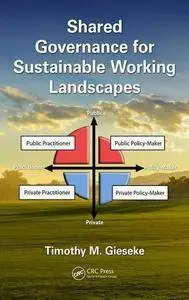Shared Governance for Sustainable Working Landscapes
CRC Press | Business & Investing | August 12, 2016 | ISBN-10: 1498718000 | 283 pages | pdf | 7.13 mb
CRC Press | Business & Investing | August 12, 2016 | ISBN-10: 1498718000 | 283 pages | pdf | 7.13 mb
by Timothy M. Gieseke (Author)
Sustaining our agricultural landscapes is no longer just a technical, scientific or even political problem, but it has evolved into a socially complex, so-called wicked problem of conflicting social governance and economics. This creates an extreme economic obstacle where the value of ecosystem services remains low and diffuse and the transactions costs remain high and multiple.Using Uber-like business platform technology and a shared governance model, a symbiotic demand for environmental benefits is created. Enabling multi-sector transactions for environmental benefits, this platform innovation would remedy the "tragedy of the commons"; the economic nemesis to achieving landscape sustainability. In a nutshell, to sustain our agricultural landscapes a transdisciplinary approach supported by a shared governance model housed within a multi-sided platform in needed. This book introduces an assessment framework identifying governance actors, styles and ratios for socio-ecological systems. The assessment uses a new governance compass to identify the types of actors completing which tasks and identifies the styles of governance used to complete the tasks. It is aimed to anyone involved in sustainability science, agricultural policy planning, or integrated landscape design.
About the Author
Timothy M. Gieseke’s interdisciplinary career is reflected in the research and insights of his writings. A master’s degree in environmental sciences is a cornerstone for his perspective on agriculture sustainability. He also brings experience in agriculture production, governmental experience in conservation planning, policy analysis at state and federal levels, political endeavors, and agribusiness management. With this near panoramic view of landscape sustainability, Tim recognized the need for a transdisciplinary approach to enable practitioners and policy- makers to transcend and blur the lines between their traditional organizational boundaries. He has carried this vision through several of his local to global efforts.
Topics
Environmental Economics
Natural Resources
Accounting & Finance
Forests & Forestry
Business & Investing
Click Here for More books



